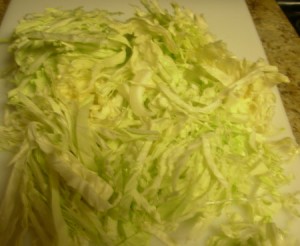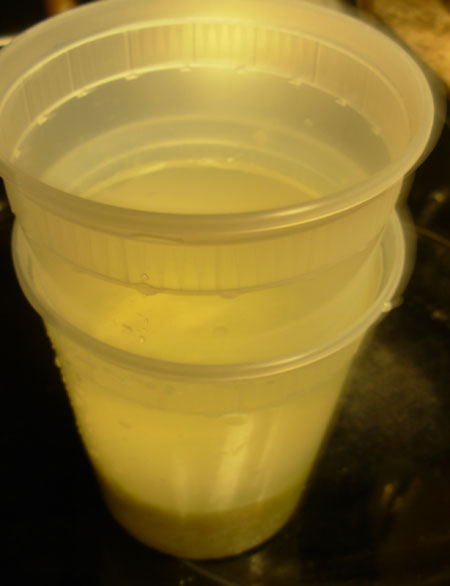Sauerkraut is probably the easiest home-fermentation project you can do. It has exactly two ingredients: cabbage and salt. It doesn’t require any special equipment. It takes some time, but once you set it up you don’t have to do anything except taste some every few days until it’s as sour as you want it.
The principle behind sauerkraut is the same as kimchi and fermented pickles: Various kinda of bacteria (including lactobacili, the guys responsible for yogurt) convert the sugars in the cabbage into acid. This lowers the pH, which gives the kraut its sour taste and preserves it by killing off any bad bacteria.
Without further ado, here’s my pretty-much-foolproof sauerkraut recipe:
 Step 1: Shred your cabbage. You can use any kind—red, green, Napa, whatever. And you can shred it as fine or as coarse as you like; just keep in mind that it’ll shrink somewhat as it becomes kraut. If you want to mix in other veggies like radish, carrot, or onion, that’s cool too.
Step 1: Shred your cabbage. You can use any kind—red, green, Napa, whatever. And you can shred it as fine or as coarse as you like; just keep in mind that it’ll shrink somewhat as it becomes kraut. If you want to mix in other veggies like radish, carrot, or onion, that’s cool too.
Step 2: Salt it. Toss the shredded cabbage with half a tablespoon of salt per pound (that’s roughly a tablespoon per head of cabbage). The exact amount of salt isn’t that important. At this point you can also add herbs or spices if you want—carraway seeds, dill, that kind of thing.
 Step 3: Pack it in a container. You want a vessel whose diameter just barely fits a plate or pot lid or something similar. (You’ll see why in the next step.) I used two Delitainers, those plastic containers you get takeout food in sometimes (which are a thousand times better and cheaper than Tupperware, by the way), because they fit perfectly into one another. Once the cabbage is in the container, you want to really mash it down tightly.
Step 3: Pack it in a container. You want a vessel whose diameter just barely fits a plate or pot lid or something similar. (You’ll see why in the next step.) I used two Delitainers, those plastic containers you get takeout food in sometimes (which are a thousand times better and cheaper than Tupperware, by the way), because they fit perfectly into one another. Once the cabbage is in the container, you want to really mash it down tightly.
Step 4: Put some weight on it. Take your plate or lid or second Delitainer and push it down on top of the cabbage. You want it to hold down the cabbage and put some pressure on it to squeeze out water. I dropped a can of beans in the inner Delitainer and it worked perfectly.
Step 5: Press and watch. Every few hours, press down on your lid. The cabbage will release a lot of water and decrease in volume. After 12 hours, you want the water level to rise above the cabbage level. Your lid should keep the cabbage submerged—keeping it out of contact with air makes sure no bad bugs can take root. If there’s not enough liquid, dissolve a teaspoon of salt in a cup of water and add some.
Step 6: Wait. The longer the kraut ferments, the more sour it will be. In a week it should be slightly sour; in two or three weeks, more intense. Once the kraut is as sour as you want, drain it, rinse it (this removes excess salt), and refrigerate until ready to use. (If you want to start a new batch immediately, pour a little bit of the old brine over the new cabbage; it’ll serve as a kind of starter.)
Step 7: Enjoy! Click through the jump to see my recipe for Bratwurst with Kraut and Apple.
Bratwurst with Kraut and Apple
Serves 2
2 links bratwurst or other sausage
1 tsp. vegetable oil
1/2 onion, sliced thin
1 cup sauerkraut
1/2 bottle beer
2-3 tsp. carraway seeds (optional)
1/2 tbsp. butter
1 apple, cored and sliced
1 tsp. brown sugar
Pinch salt
Preheat oven to 375°.
Heat a small oven-safe pan over medium heat. Add bratwurst and brown on both sides. Remove and set aside. Add oil and onion; cook until onion is soft and translucent, 3-5 minutes. Add sauerkraut, beer, and carraway seeds; stir to combine. Place bratwurst on top, put pan in oven, and cook 30 minutes or until bratwurst are fully cooked.
Drink the other half of the beer.
Heat another pan over medium heat. Add butter; when foam subsides, add apple and sprinkle with brown sugar and salt. Cook, stirring, until tender, about 5 minutes.
Scatter apple atop bratwurst and sauerkraut; serve with German mustard on the side.
